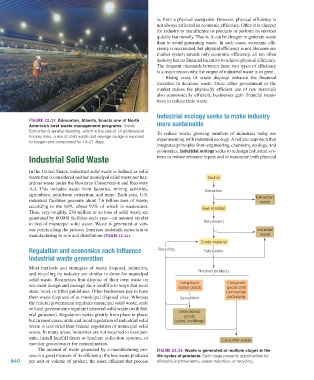Page 641 - Environment: The Science Behind the Stories
P. 641
is, from a physical standpoint. However, physical efficiency is
not always reflected in economic efficiency. Often it is cheaper
for industry to manufacture its products or perform its services
quickly but messily. That is, it can be cheaper to generate waste
than to avoid generating waste. In such cases, economic effi-
ciency is maximized, but physical efficiency is not. Because our
market system awards only economic efficiency, all too often
industry has no financial incentive to achieve physical efficiency.
The frequent mismatch between these two types of efficiency
is a major reason why the output of industrial waste is so great.
Rising costs of waste disposal enhance the financial
incentive to decrease waste. Once either government or the
market makes the physically efficient use of raw materials
also economically efficient, businesses gain financial incen-
tives to reduce their waste.
Industrial ecology seeks to make industry
FIGURE 22.13 Edmonton, Alberta, boasts one of North
America’s best waste management programs. Inside more sustainable
Edmonton’s aeration building, which is the size of 14 professional To reduce waste, growing numbers of industries today are
hockey rinks, a mix of solid waste and sewage sludge is exposed experimenting with industrial ecology. A holistic approach that
to oxygen and composted for 14–21 days.
integrates principles from engineering, chemistry, ecology, and
economics, industrial ecology seeks to redesign industrial sys-
Industrial Solid Waste tems to reduce resource inputs and to maximize both physical
In the United States, industrial solid waste is defined as solid
waste that is considered neither municipal solid waste nor haz- Source
ardous waste under the Resource Conservation and Recovery
Act. This includes waste from factories, mining activities, Extraction
agriculture, petroleum extraction, and more. Each year, U.S. Extraction
industrial facilities generate about 7.6 billion tons of waste, waste
according to the EPA, about 97% of which is wastewater. Raw material
Thus, very roughly, 230 million or so tons of solid waste are
generated by 60,000 facilities each year—an amount similar
to that of municipal solid waste. Waste is generated at vari- Refinement
ous points along the process from raw materials extraction to Industrial
manufacturing to sale and distribution (FIGURE 22.14). waste
Crude material
Regulation and economics each influence Recycling Fabrication
industrial waste generation
Most methods and strategies of waste disposal, reduction,
and recycling by industry are similar to those for municipal Finished products
solid waste. Businesses that dispose of their own waste on
Long-lived
Consumer
site must design and manage their landfills in ways that meet capital goods goods and
state, local, or tribal guidelines. Other businesses pay to have commercial
their waste disposed of at municipal disposal sites. Whereas Demolition packaging
the federal government regulates municipal solid waste, state
or local governments regulate industrial solid waste (with fed-
eral guidance). Regulation varies greatly from place to place, Demolished
goods
but in most cases, state and local regulation of industrial solid (autos, buildings)
waste is less strict than federal regulation of municipal solid
waste. In many areas, industries are not required to have per-
mits, install landfill liners or leachate collection systems, or Consumer waste
monitor groundwater for contamination.
The amount of waste generated by a manufacturing pro- FIGURE 22.14 Waste is generated at multiple stages in the
cess is a good measure of its efficiency; the less waste produced life cycles of products. Each stage presents opportunities for
640 per unit or volume of product, the more efficient that process efficiency improvements, waste reduction, or recycling.
M22_WITH7428_05_SE_C22.indd 640 13/12/14 2:25 PM

